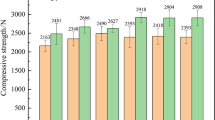Abstract
Double-layered pellet (DLP) roasting is a novel pretreatment method for sulfur and arsenic-bearing gold concentrates. In this process, preparation of DLPs is a fundamental step which is required to produce DLPs with favorable mechanical strength and thermal stability. Studies were carried out to investigate the affecting factors and conditions on the preparation and properties of DLPs. The results show that moisture content has significant influence on DLPs preparation. With the increase of moisture content in the range of no more than 9.8%, drop resistance and compressive strength of green DLPs are raised and the pelletizing dynamics is improved accordingly. The optimum conditions are determined as moisture content of 9.8%, coating time of 14–16 min, drying temperature <80 °C and drying gas velocity <1.2 m/s. When DLPs prepared under these conditions are roasted at 600 °C for 1 h, favorable removal and solidifying rates can be obtained, in which the removal rates of arsenic and sulfur are 94.38% and 82.55%, and the solidifying rates of arsenic and sulfur reach 99.62% and 99.79%, respectively. These results promise industrial application of DLP roasting.
Similar content being viewed by others
References
MA Ying-qiang, LUO Xi-mei, YIN Wan-zhong, YAO Jin, LIU Ming-bao, HONG Jong-su. Separation tests of low-grade gold ore with high sulfur and arsenic [J]. Advanced Materials Research, 2012, 454: 285–291.
LI Qian, JIANG Tao, YANG Yong-bin, LI Guang-hui, QIU Guan-zhou. Bio-oxidation of arsenopyrite [J]. Transactions of Nonferrous Metals Society of China, 2008, 18(6): 1433–1438.
SENANYAKE G. Gold leaching in non cyanide lixiviant systems: critical issues on fundamentals and applications [J]. Minerals Engineering, 2004, 17(6): 785–801.
YIN Shu-yan, YANG Hong-ying. Technology and progress in high pressure oxidation for refractory gold ores [J]. Precious Metals, 2008, 29(1): 56–59. (in Chinese)
FEMANDEZ R, COLLINS A, MARCZAK E. Gold recovery from high-arsenic-containing ores at Newmont’s roasters [J]. Minerals and Metallurgical Processing, 2010, 27(2): 60–64.
LI J, DABROWSKI B, MILLER J, ACAR S, DIETRICH M, LEVIER K, WAN R. The influence of pyrite pre-oxidation on gold recovery by cyanidation [J]. Minerals Engineering, 2006, 19(9): 883–895.
BRIERLEY J A. A perspective on developments in biohydrometallurgy [J]. Hydrometallurgy, 2008, 94(1/2/3/4): 2–7.
YANG Wei, LIU Rui-qiang, REN Yun-chao, QIN Wen-qing. Extraction of Au from high arsenic refractory gold concentrate by bacterial oxidation-cyanidation [J]. Journal of Nonferrous Metals, 2011, 21(5): 1151–1158. (in Chinese)
CUI Ri-cheng, YANG Hong-ying, CHEN Sen, ZHANG Shuo, LI Ke-feng. Valence variation of arsenic in bioleaching process of arsenic-bearing gold ore [J]. Transactions of Nonferrous Metals Society of China, 2010, 20(6): 1171–1176.
AKCIL A, CIFTC H. Pretreatments applied to refractory gold ores [J]. Madencilik, 2009, 48(1): 17–30.
DUNN J, CHAMBERLAIN A. The recovery of gold from refractory arsenopyrite concentrates by pyrolysis-oxidation [J]. Minerals Engineering, 1997, 10(9): 919–928.
DEMOPOULOS G, PAPANGTLAKIS V. Recent advances in refractory gold processing [J]. CIM Bulletin, 1989, 931(82): 85–91.
LIU Han-zhao. The current status and prospects of roast oxidation for refractory gold ores at home and abroad [J]. Metallic Ore Dressing Abroad, 2005, 42(7): 5–11. (in Chinese)
TOMKINS A, FROST B, DAVID R. Arsenopyrite melting during metamorphism of sulfide ore deposits [J]. Canadian Mineralogist, 2006, 44(5): 1045–1062.
JIANG Guo-hong, LIU Sheng-ming, ZHANG Yue. Examination on solidification roast and cyanide leaching of gold concentration containing arsenic and sulfur [J]. Hydrometallurgy, 2004, 23(2): 76–79. (in Chinese)
KOU Jian-jun, WU Ping. A study on treating technology for a refractory gold ore [J]. Multipurpose Utilization of Mineral Resource, 2002(6): 3–5. (in Chinese)
TERRY B, RIBEROS G, SANCHEZ M, JEFFES J. Lime-concentrate process for roasting of copper-bearing sulphides [J]. Trans Inst Min Metall Sect, 1994, 103: 193–200.
HAO Xian-hua, ZHANG Gui-Hua, SHENG Gui-yun. Study on sulfur-fixing agent used in pretreatment roast of refractory gold ore [J]. Gold, 2001, 22(8): 27–30. (in Chinese)
Author information
Authors and Affiliations
Corresponding author
Additional information
Foundation item: Project(51074182) supported by the National Natural Science Foundation of China; Project(201012200032) supported by the Fundamental Research Funds for the Central Universities, China
Rights and permissions
About this article
Cite this article
Yang, Yb., Cui, Ln., Li, Xs. et al. Novel technology on preparation of double-layered pellets for sulfur and arsenic-bearing gold concentrates. J. Cent. South Univ. 20, 2967–2973 (2013). https://doi.org/10.1007/s11771-013-1820-4
Received:
Accepted:
Published:
Issue Date:
DOI: https://doi.org/10.1007/s11771-013-1820-4




